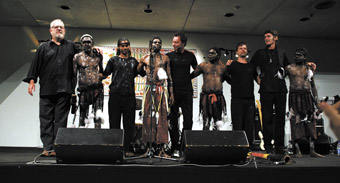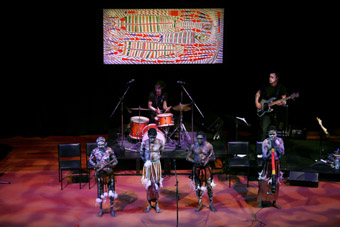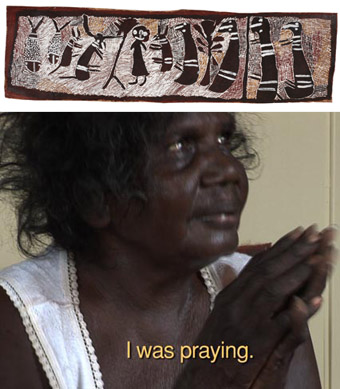kindred spirits
keith gallasch, virginia baxter: crossing roper bar, darwin festival

Crossing Roper Bar, Australian Art Orchestra, Wagilak Gujarra and Nyilapapidgi musicians of Ngukurr
photo Bohdan Warchomij
Crossing Roper Bar, Australian Art Orchestra, Wagilak Gujarra and Nyilapapidgi musicians of Ngukurr
A BRIEF VISIT TO DARWIN ALLOWED US TO ENJOY A SMALL PART OF MALCOLM BLAYLOCK’S FINAL DARWIN FESTIVAL PROGRAM. IT INCLUDED THE 25TH TELSTRA NATIONAL ABORIGINAL AND TORRES STRAIT ISLANDER ART AWARDS EXHIBITION AT THE MUSEUM AND ART GALLERY OF THE NORTHERN TERRITORY, A SHOW OF ASTONISHING ARTISTRY AND DIVERSITY, AND CROSSING ROPER BAR, A POWERFUL COLLABORATION BETWEEN THE AUSTRALIAN ART ORCHESTRA AND WAGILAK GUJARRA AND NYILAPAPIDGI MUSICIANS OF NGUKURR IN ARNHEM LAND ON THE ROPER RIVER.
When not isolated for several months by the flooded river during the wet season, the small town of Ngukurr can be reached by crossing Roper Bar. As the program note suggests, “the crossing over seems not only a poetic but a fitting metaphor for the collaboration…” A substantial part of AAO’s history and reputation has been built on cross-cultural collaborations—with classical Balinese artists in The Theft of Sita (1999-2002) and Indian musicians in Into the Fire (1999), both creations managing the difficult balancing act of maintaining cultural and aesthetic integrity for each of the partners but yielding something new.
The performance is staged informally on the open-air Star Shell stage in the Darwin Botanic Gardens which also provide an ideal festival venue for eating inexpensive, quality food and taking in adjoining art exhibitions, one in an old timber church (Ta Teut Amarasi/Awakening: delicate West Timor textile and print works from an Asialink sponsored workshop visit of Darwin artists to the village of Baun), the other on the whitened trunks of a grove of palm trees. The four Art Orchestra musicians (keyboards Paul Grabowksy, bass Chris Bekker, saxophones, flutes, clarinet Tony Hicks, drums Rajiv Jayaweera, guitars Stephen Magnusson) are spread wide across the stage. Centrestage are the four ceremonially attired Ngukurr men (songman Roy Wilfred, didjeridu man David Wilfred, songman Benjamin Wilfred, dancer Johnston Hall, although their roles sometimes interchange, while only one does most of the dancing).

rossing Roper Bar, Australian Art Orchestra, Wagilak Gujarra and Nyilapapidgi musicians of Ngukurr
photo Bohdan Warchomij
rossing Roper Bar, Australian Art Orchestra, Wagilak Gujarra and Nyilapapidgi musicians of Ngukurr
The first part of Crossing Roper Bar emerges from a slowly escalating, disjointed sonic field generated by the band and joined by Aboriginal singing, screaming sax, raw electric guitar and didjeridu. It’s hard to pick the shape until a sudden pause after which the clap sticks palpably set the rhythm and the cultural disparity of the nervy opening—hardcore jazz and traditional Indigenous song—suddenly dissolves and the musics roll together and inexorably on, ending with a plangent sax line.
Between the collaborative pieces Ruby Hunter joins the band, her rich mezzo duetting with the warbling sax of Tony Hicks who plays with the ease and fluency of Wayne Shorter’s dialogues with Joni Mitchell. Hunter chats with the audience about her songs—one about basket weaving and spirit fish, the other about her empathy for her Aboriginal sisters in prison (“each day it’s real/ I know how you feel”). Less certain are the sources of the Ngukurr men’s songs—we learn about them later.
The second Crossing Roper Bar improvisation delivers the beautiful entwining of the two songman voices, one a higher tenor than the other, and another busy collaborative amalgam riding on a wave of rise and fall to which is added a big, surprising collective cry from all the Ngukurr men, a soaring sax solo and the first of the dances from Johnston Hall, executed dextrously within the space of a few steps.
Hunter returns to sing of a childhood living on the streets in Adelaide. Here she abandons her trademark vibrato for long held notes (juxtaposed with a supple quickfire saxophone) and a soaring, emotional chorus.
Prior to the final improvisations, Benjamin Wilfred tells us about the death of a man he greatly admired and learned much from, his grandfather, Sambo Barra Barra, a noted visual artist, “a pioneer.” Of the collaboration with the Australian Art Orchestra, he says, “We mix and I like it.” This time the pulse and the drive of the piece seems to come primarily from the Ngukurr men, with the two voices rising over dense instrumental textures and dramatically, and effectively, in and out of synch. Benjamin Wilfred takes over the didjeridu and David Wilfred joins the dancing. No one seems quite sure when the music is going to stop as each apparent close becomes just a pause before the return to a collective powering on, carrying us with it as one.
The confidence of the final stages of the performance contrasts with the tentativeness of the earlier pieces where the complexities of the collaboration seemed more apparent in the careful watching and subtle signalling between all the musicians, not least in the large number of eyes trained on Grabowsky who kept his gestures minimal. The music seemed to flow more easily when the Art Orchestra took its cue from the Indigenous artists. There was something less comfortable about the Ngukurr men waiting to place themselves in the flux of the jazz idiom. But, then again, why not, it’s a two-way street and there’s more to this than meets my naive ear. Later, at a public forum, Grabowksy tells us that “(the Indigenous artists) are in the driver’s seat.” I long for the CD if there is to be one. Certainly I might have better assimilated the meeting of two complex musical systems had Hunter performed her songs first with the Crossing Roper Bar pieces then presented consecutively. But this was a wonderful cultural event, ecstatically received by its fully engaged audience.
At the Northern Territory State Library, Genevieve Campbell (who organised a project with Tiwi women of Bathurst Island called We Sing Songs performed at last year’s Darwin Festival and more recently at the Sydney Opera House Studio) facilitated a conversation with the AAO’s Paul Grabowsky and producer Tos Mahoney of Perth’s Tura New Music. TNM arranged the tour of Crossing Roper Bar from Darwin to Perth via eight towns in the Northern Territory and Western Australia.
Grabowsky spoke about the idea of setting his orchestra apart from others by deciding it would be a group of improvising musicians as opposed to interpreters of composed music. Written music, says Grabowsky, is “like a street directory. It’s not the music. Music happens when people play music.” The interest for the orchestra was to be in process, what instruments can do, how to make them work in the moment and (as in all good improvisation) how to evolve structures. He said the same applies to good storytelling and he’s interested in that relationship too, aptly for a collaboration with a culture where the distinction between music and telling does not exist. Of The Theft of Sita, Grabowsky said that working with classical Balinese musicians the tuning was the opposite of Western instruments. “We were working with a clangorous resonance as opposed to a euphonious paradigm.” As a result, the AAO musicians came to love “out of tune-ness.” Working with master musicians of Southern India, he said, they were challenged by the complex rhythmic structures of the music, but took those on too to great effect.
When he first met the Ngukurr musicians, Grabowksy thought he would try to make a connection by telling them how he’d just come from working with black musicians in New York. “Oh, I’ve been to New York”, said the youngest of the songmen. He was amazed at the songmen’s pitch control—”they sing in microtones.” He thinks the lead songman, Roy Wilfred, “one of the best singers in the country.’
Grabowsky explained that Crossing Roper Bar comprises a cycle of songs that includes welcomes and farewells, songs pertaining to certain birds, to the wind, and one concerning a wild man walking through his land, singing the land. He described the songs as powerful, adding that working with Indigenous musicians involves trying to grasp complex cultural notions such as “singing into being”, “singing of ancestors”, “singing of place”, like multiple parallel universes. The songmen insisted that the AAO musicians learn some of their language, study and learn the traditional song cycle, and “be ready to be told off if out of line.”
Speaking of the challenges of the collaboration, Grabowsky said that the 2007 version of Crossing Roper Bar for the Queensland Music Festival involved female dancers but proved unwieldy. It was felt that clarity was important: “The project is both strong and fragile. It could easily go off the rails. It has to be treated like a newborn baby. Right now, it’s keeping us up late.”
Paul Grabowsky is passionate about the need for white Australians to connect with and learn from Indigenous Australians: “Engage in whatever ways you can. Indigenous people carry the solution to all the problems we’re experiencing with the land right now, what to do about the water and so on. Music is just a metaphor for this conversation.”

Incident at Mutpi, 1975, Nyapanyapa Yunupingu, bark painting and video still
incident at mutpi, 1975
Amidst the various winners in the 25th Telstra National Aboriginal and Torres Strait Islander Art Award exhibition at the Museum and Art Gallery of the Northern Territory was Nyapanyapa Yunupingu, sister of painter Gulumbu and musician and leader Galarrwuy, for her work Incident at Mutpi, 1975. She won the Wandjuk Marika 3D Memorial Award. It’s an intimate work in a corner in a gallery room otherwise populated with epic visions of the land. The work is in two parts. A bark painting narrating the artist’s goring by a buffalo in 1975 hangs above a video screen on which Yunupingu speaks in vivid detail about the experience to a local gathering whom we can’t see and to whom she sometimes cantankerously takes exception: “It’s not funny.” At the end we hear one of the listeners exhort her to “Tell the story shorter.”
The video is engagingly and amusingly frank and the beautiful, contemplative painting is purportedly the first from north-east Arnhem Land to use a bark to tell a private story. The video is titled Gatapangawuy Dhawu—Buffalo Story, and was shot by The Mulka Project, Yirrkala’s new multimedia studio (Buku-Larrnggay Mulka Centre). The effect of the juxtaposition of traditional art and modern media for the Incident at Mutpi, 1975 is at once simple and complex, like Crossing Roper Bar, vividly accessible at one level, rich in suggestion and cultural possibilities at another.
–
Darwin Festival: Tura New Music, Crossing Roper Bar, Australian Art Orchestra, Wagilak Gujarra and Nyilapapidgi musicians of Ngukurr, Darwin Festival, Star Shell, Botanic Gardens, Aug 17; 25th Telstra National Aboriginal and Torres Strait Islander Art Awards, Museum and Art Gallery of the Northern Territory, Darwin, Aug 15-Oct 26
RealTime issue #87 Oct-Nov 2008 pg. 10






